This Spring, Add Some Biodiversity to Your Yard
Photos by Blake Goll, Jennifer Mathes and Monica McQuailSpring 2023 trends are here, and one thing is clear — manicured lawns are out and natural ecosystems are in. It’s time to create habitat at home, no matter how big or small your backyard may be. The birds, bees and butterflies will surely thank you for adding some biodiversity to your yard.
Killer Lawns
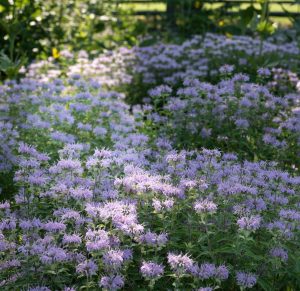 First gaining popularity at the homes of wealthy landowners in 17th-century England, lush green lawns were introduced to the United States in the 1800s. The 1950s saw the use of pesticides, fertilizers and herbicides, and as suburbs grew, so did these small plots of grass devoid of weeds or pesky bugs.
First gaining popularity at the homes of wealthy landowners in 17th-century England, lush green lawns were introduced to the United States in the 1800s. The 1950s saw the use of pesticides, fertilizers and herbicides, and as suburbs grew, so did these small plots of grass devoid of weeds or pesky bugs.
Today, lawns make up 40 to 50 million acres, a number that equals this country’s national parks combined. That’s a lot of lawn to maintain. And it’s about time we ask ourselves, “Is it worth it?”
Despite their popularity, lawns are inherently a contradiction. They’re the most-grown crop in the U.S., yet they don’t produce sustainable food that wildlife or humans can actually eat. Lawns are a staple of American suburban life, yet they were imported from England. In fact, the most prized grass in our country — Kentucky bluegrass — is native to Europe and the Middle East, not Kentucky.
Lawns evoke a sense of ease and leisure, yet they require an inordinate amount of work, time and money to maintain. Their lush green color signifies life, yet caring for them pollutes the earth. In reality, lawnmowers emit noise pollution and pollutants into the air, and fertilizers contaminate our water and harm aquatic life.
What to Do?

With increasing research that suggests we’re in the midst of an extinction crisis — North American bird populations have declined by a third, 82 native fish species are imperiled, and our pollinators are disappearing at an alarming rate — one of the most important things you can do to help save these diminishing species is to convert your backyard to viable habitat that is biodiverse, meaning it can support all sorts of life.
Converting your lawn may sound like a daunting task, but the good news is you can start to regenerate biodiversity little by little. And you can hop on this trend even if you don’t have a lawn!
The most important step in adding some biodiversity to your home is to plant native plants (see plant list below). Begin by incorporating native species into your garden around your home, and even on your balcony, terrace or deck in containers.
Not only are native plants visually appealing, but they require less water and are easier to maintain, unlike their invasive counterparts. Planting just one native plant in your yard can offer a myriad of benefits to our planet.
Native Plants
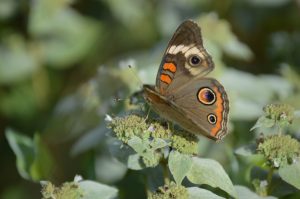
Looking below the surface, native flowers, shrubs and trees have long root systems that not only suck up more water to help diminish flooding, but also filter out harmful nutrients and salts that would otherwise travel to our waterways and harm the fish there. In comparison, turf grasses often planted in yards have shallow and dense root systems, which do very little to absorb rain water. Native plants also have the added benefit of being able to use the beneficial nutrients already present in your soil, thus eliminating the need to buy pricey fertilizers to promote growth.
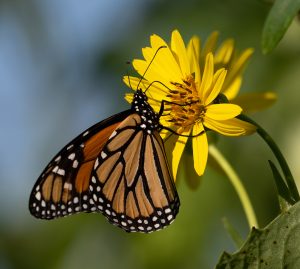
Above ground, native plants produce flowers, berries and leaves that provide long-lasting and nutrient-dense sustenance to pollinator species like bees and butterflies, as well as the birds in our area. Additionally, native shrubs and trees offer valuable shelter where wildlife can raise their young.
As your yard becomes a haven that supports a web of life, you’ll likely find those pesky bugs that you’d normally need pesticides to eradicate now get eaten up by other species.
What to Plant for Biodiversity?
For Birds:
-
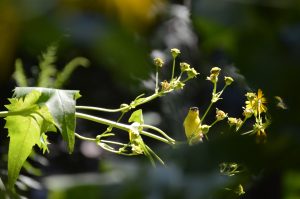
Bird hidden in Virginia cup plant Composite flowers, spruces, hemlocks, pine bring house finch, purple finch, Cassin’s finch, American goldfinch, lesser goldfinch, pine siskin
- Birches and sumacs bring black-capped chickadee, Carolina chickadee, mountain chickadee, tufted titmouse, juniper titmouse, oak titmouse
- Pines, hickories, oaks, cherries bring downy woodpecker, hairy woodpecker, red-bellied woodpecker, ladder-backed woodpecker, white-headed woodpecker, northern flicker
- Oaks and beeches bring American crow, fish crow, northwestern crow, blue jay, Carolina scrub-jay, woodhouse scrub-jay, Florida scrub-jay
- Sunflowers, elderberries, serviceberries bring northern cardinal, rose-breasted grosbeak, black-headed grosbeak, blue grosbeak, scarlet tanager, western tanager
-
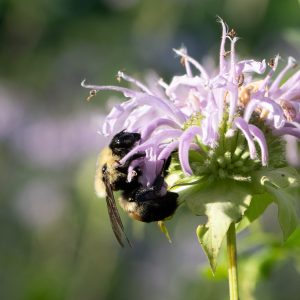
Bumblebee on bee balm Blackberries and wild grasses bring dark-eyed junco, white-throated sparrow, white-crowned sparrow, song sparrow, lark sparrow
- Columbine, jewelweed, bee balm bring hummingbirds
For Butterflies and Caterpillars:
- Trees, such as native birches, maples oak trees, willows
- Flowers, such as goldenrod, milkweed, sunflowers
For Bees:
- Aster, black-eyed Susan, dogwood, goldenrod, ironweed, prairie clover, prairie coneflower, thistle, tickseed, wingstem
Join the Movement

By adding biodiversity to your yard, not only are you helping the other beings around you, but you’re also contributing to the larger “Homegrown National Park Movement.” This movement aims to turn half — that’s about 20 million acres — of all privately owned green lawns in the U.S. into native plantings. Small efforts by many can make a world of difference. More at HomegrownNationalPark.org.
Gone are the days when lawns existed purely for curb appeal. Your backyard should provide joy, nourishment and life for all inhabitants, from the Monarch caterpillar munching on milkweed and the goldfinch looking for seeds among some purple aster, to the children who stare with wonder at this incredible world.
After all, if something is not eating your plants, then your garden is not part of the ecosystem. We’re predicting this trend is one that is going to last.
Willistown Conservation Trust focuses on 28,000 acres within the watersheds of Ridley, Crum and Darby Creeks. Since 1996, the Trust has permanently conserved over 7,500 acres, including three nature preserves open to the public: Ashbridge, Kirkwood and Rushton Woods Preserves, the latter home to Rushton Conservation Center and Rushton Farm. Join the Trust for “Habitat at Home” programming, held throughout the year. Learn more about biodiversity at WCTrust.org and by following @WCTrust.
Our Favorite Resources
- B&D Builders
- Ball & Ball
- Berk Hathaway Holly Gross
- Berk Hathaway Kit Anstey
- Berk Hathaway M. Schwartz
- Canvas Valley Forge
- Dewson Construction
- DiSabatino Landscaping
- King Construction
- McComsey Builders
- Monument/Sotheby’s Int’l
- Mostardi Nursery
- Mountaintop Construction
- Renewal Dynamics
- Sheller Energy
- White Horse Construction
